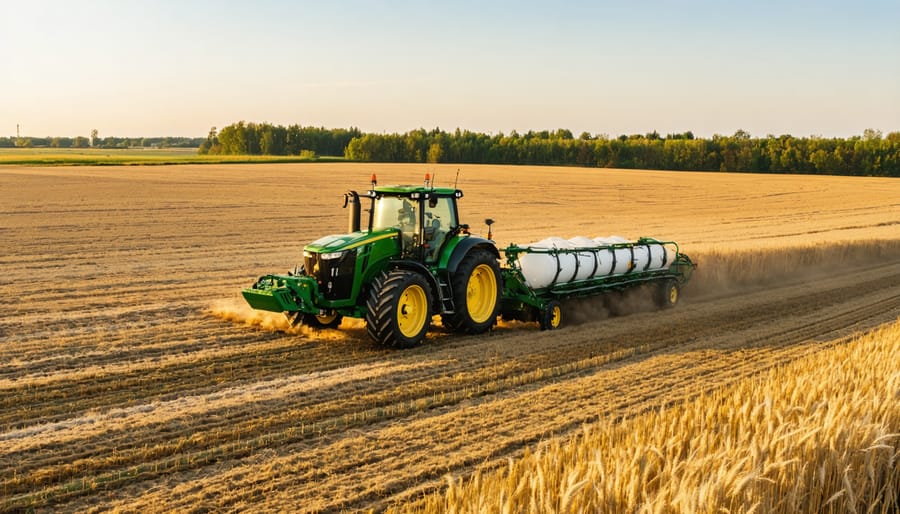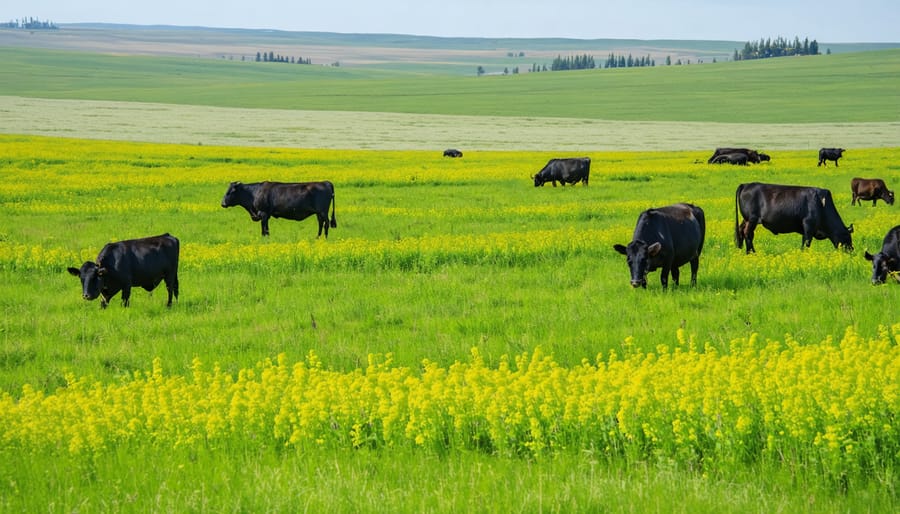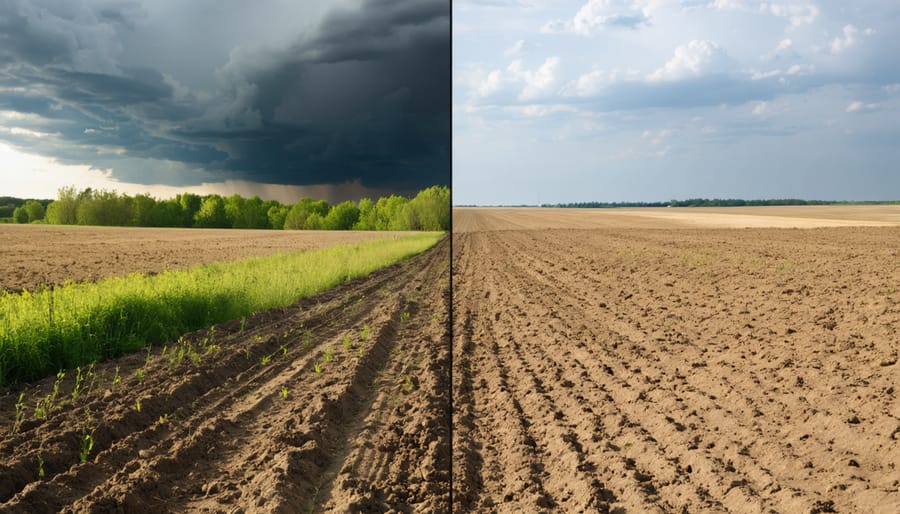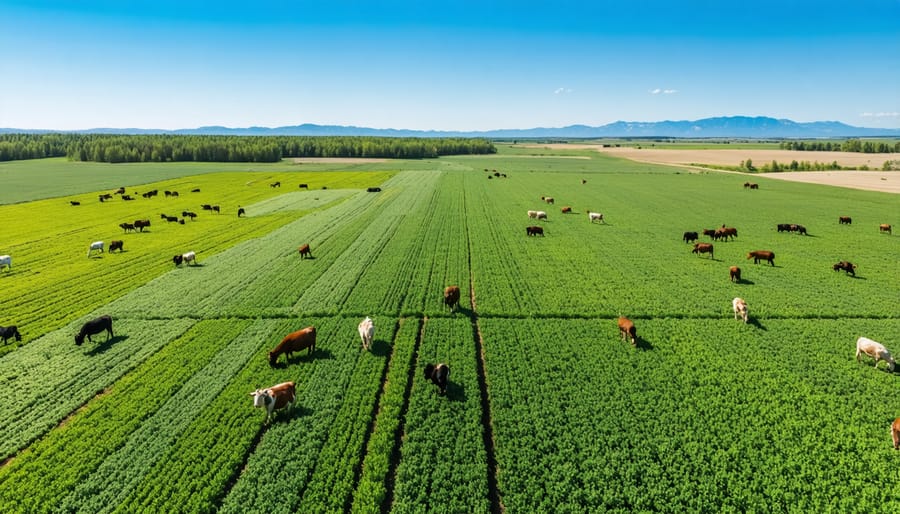As Canadian farmers face mounting pressure to increase yields while protecting soil health, the stark contrast between agroecology and industrial agriculture has never been more relevant. In southern Alberta’s wheat fields, third-generation farmer Sarah Thompson reduced input costs by 40% after transitioning from conventional methods to agroecological practices, while maintaining comparable yields through integrated pest management and crop diversification.
The choice between these farming approaches extends far beyond simple economics. Agroecology emphasizes working with natural ecosystems, building soil fertility through biological processes, and maintaining biodiversity, while industrial agriculture prioritizes efficiency through mechanization, synthetic inputs, and monoculture production. Recent studies from the University of Alberta demonstrate that agroecological farms typically use 60% less fossil fuel energy per hectare while sequestering more carbon and supporting greater pollinator populations.
For Alberta’s 45,000 farms, this isn’t just an academic debate – it’s about finding practical solutions that balance productivity with long-term sustainability. As climate patterns become increasingly unpredictable, the resilience built into agroecological systems offers a compelling alternative to the input-dependent industrial model, particularly for mid-sized operations seeking to reduce their environmental impact while maintaining profitability.
The Real Cost of Industrial Agriculture in Alberta
Environmental Impact Assessment
The environmental footprint of our farming practices has become increasingly important to Alberta farmers. When comparing agroecological and industrial agriculture approaches, the impact on our natural resources tells a compelling story.
Studies from the University of Alberta show that conventional industrial farming practices can lead to soil organic matter decline of up to 2% annually in our prairie regions. This loss affects both soil structure and water retention capacity. In contrast, farms implementing agroecological methods have reported up to 60% improvement in soil health over five years through practices like cover cropping and crop rotation.
Water quality testing in agricultural regions reveals that industrial farming can contribute to elevated phosphorus levels in local waterways, sometimes exceeding 0.5 mg/L. Meanwhile, Alberta farmers using agroecological buffer zones have reduced nutrient runoff by up to 85% in adjacent water bodies.
Biodiversity measurements across the province show that industrial monocultures support approximately 60% fewer bird species compared to diversified agroecological farms. Local success stories, like the MacIntyre Family Farm near Red Deer, demonstrate how integrating natural habitats with farming operations has doubled pollinator populations while maintaining productive yields.
These findings highlight the importance of considering long-term environmental impacts when choosing farming approaches.

Economic Dependencies
The economic realities of farming methods reveal stark contrasts in financial dependencies. Industrial agriculture typically requires significant upfront investments in machinery, synthetic inputs, and specialized seeds, often leading to substantial debt loads for farmers. In Alberta, the average farm carries over $400,000 in debt, largely due to industrial input costs and equipment financing.
Agroecological approaches, while requiring initial investment in soil health and biodiversity, generally result in lower ongoing input costs. Local farmer Sarah McKenzie from Red Deer County reports reducing her input costs by 40% over three years after transitioning to agroecological practices, primarily through decreased reliance on commercial fertilizers and pesticides.
Market vulnerabilities also differ significantly. Industrial agriculture often ties farmers to specific suppliers and buyers, creating dependency on global market prices and corporate supply chains. Conversely, agroecological systems typically diversify income streams through multiple crops and local market connections, providing better economic resilience.
Calgary-based agricultural economist Dr. James Peterson notes that while industrial systems can generate higher gross revenues in good years, agroecological approaches often show more stable net profits over time, particularly during challenging seasons or market fluctuations. This stability comes from reduced input costs and greater adaptability to changing conditions.
Agroecological Success Stories from Canadian Farms
The Miller Family Farm Transformation
The Miller family farm, located just outside of Olds, Alberta, stands as a compelling example of successful transition from conventional to agroecological farming practices. Over the past decade, John and Sarah Miller, third-generation farmers, have transformed their 640-hectare operation into one of the region’s most innovative integrated farming systems.
The Millers began their transition in 2014 after facing declining soil health and increasing input costs. Their step-by-step approach started with introducing cover crops and implementing rotational grazing for their cattle herd. They divided their pastures into smaller paddocks, moving livestock every few days to promote optimal grass recovery and natural fertilization.
Within three years, the Millers observed significant improvements in soil organic matter, increasing from 2% to 4.5%. Water retention improved dramatically, allowing them to reduce irrigation needs by 30%. They integrated heritage wheat varieties that proved more resilient to local weather conditions and required fewer inputs.
The farm now operates as a diverse ecosystem, combining cattle, crops, and native pollinator habitats. Their annual input costs have decreased by 40%, while crop yields have stabilized at levels comparable to their previous conventional methods. The Millers also report increased profit margins due to premium pricing for their organic products and reduced operational expenses.
Perhaps most notably, their success has inspired fifteen neighboring farms to begin their own transitions to agroecological practices. The Millers regularly host field days and workshops, sharing their experiences and helping build a stronger, more sustainable farming community in central Alberta.

Community-Supported Agriculture Success
The Sunrise Farm Collective in Red Deer County stands as a shining example of how community-supported agriculture (CSA) can successfully implement agroecological principles. Started in 2018 by a group of five local farming families, this initiative now serves over 300 households while maintaining ecological balance and soil health.
The collective operates on a shared-resource model, where members pool equipment, labour, and knowledge. Each farm specializes in different crops or livestock, creating a diverse and resilient food system. Participating farms rotate crops annually and integrate livestock management, resulting in improved soil fertility and reduced pest pressures without chemical inputs.
What makes this model particularly successful is its strong community engagement. Members participate in seasonal work parties, contributing to everything from planting to harvest. This hands-on involvement has created a deeper understanding of food production among urban participants while providing farms with reliable labour during peak seasons.
The financial structure is equally innovative. Members pre-purchase shares of the harvest, providing farmers with stable income and shared risk management. This model has helped participating farms increase their revenue by an average of 40% compared to conventional market sales, while keeping food costs reasonable for members.
The collective also partners with local schools for educational programs and works with new farmers through mentorship initiatives. Their success has inspired similar projects across Alberta, with three new CSA collectives launching in the past two years. The Sunrise model demonstrates how agroecological principles can create economically viable farms while building stronger communities and healthier ecosystems.
Practical Steps for Agroecological Intensification
Soil Health Management
In agroecological systems, soil health management focuses on building and maintaining living soil ecosystems rather than relying solely on synthetic inputs. Alberta farmers are increasingly adopting soil regeneration techniques that work with nature rather than against it.
Key practices include crop rotation with nitrogen-fixing legumes, which naturally enhance soil fertility while breaking pest and disease cycles. Cover cropping between main growing seasons protects soil from erosion and adds organic matter, particularly important during our harsh prairie winters. Many local farmers report success with winter rye and field peas as cover crops.
Composting and the application of animal manure provide slow-release nutrients while improving soil structure and water retention. For example, the Morrison family farm in Red Deer County has reduced fertilizer costs by 40% through implementing an on-farm composting system.
Minimizing soil disturbance through reduced tillage practices helps maintain soil structure and protect beneficial microorganisms. The natural soil food web, including earthworms, fungi, and bacteria, works to break down organic matter and make nutrients available to crops. This biological activity creates a more resilient growing environment that’s better equipped to handle drought and extreme weather events – increasingly important for Alberta’s variable climate.
Success in soil health management requires patience and observation, but the long-term benefits include reduced input costs, improved water efficiency, and more stable yields.

Biodiversity Integration
Integrating biodiversity into farming systems creates resilient ecosystems that naturally support crop production. Many Alberta farmers are discovering that working with nature, rather than against it, can reduce input costs while improving yields. By implementing circular agriculture principles, farms can become self-sustaining ecosystems.
Key strategies include planting diverse hedgerows along field boundaries, which provide habitat for beneficial insects and birds that control pest populations. Prairie farmers have reported up to 60% reduction in pest-related crop damage after establishing native plant corridors. Incorporating companion planting, where complementary crops are grown together, enhances natural pest control while maximizing space utilization.
Creating beetle banks – raised strips planted with native grasses – offers shelter for predatory ground beetles that feed on crop pests. Local success stories include the Davidson family farm near Red Deer, which eliminated synthetic pesticide use after establishing a network of beetle banks throughout their 400-hectare operation.
Water features like small ponds and wetlands attract natural predators while providing irrigation benefits. Even simple additions like installing bird boxes can significantly boost natural pest control – a single barn swallow family can consume up to 6,000 insects daily during breeding season.
These biodiversity measures not only support pest management but also improve soil health, water retention, and overall farm resilience.
Water Conservation Strategies
In Alberta’s semi-arid climate, effective water management is crucial for both agroecological and industrial farming approaches. Agroecological methods typically focus on working with natural water cycles, implementing strategies like contour farming and riparian buffer zones that slow water movement and increase soil absorption.
Many Alberta farmers have found success with precision irrigation systems that utilize soil moisture sensors and weather monitoring to optimize water usage. For example, the Henderson family farm near Lethbridge reduced their water consumption by 30% by implementing drip irrigation in their market garden operation while maintaining crop yields.
Cover cropping has proven particularly effective in our climate, with crops like fall rye and winter wheat helping to retain soil moisture and prevent erosion during our dry winters. These crops also contribute to improved soil structure, allowing better water penetration and retention throughout the growing season.
Wetland preservation plays a vital role in natural water management. Progressive farmers are now protecting and restoring wetlands on their properties, creating natural water retention systems that benefit both agriculture and local ecosystems. The Alberta Wetland Policy supports these efforts through various incentive programs.
For smaller-scale operations, mulching and companion planting have shown impressive results in reducing water requirements. These methods, combined with timing irrigation during early morning or evening hours, help minimize evaporation losses in our often windy conditions.
Resources and Support for Transition
Farmers considering the transition to agroecological practices can access numerous support systems across Canada. The growing agroecology sector has fostered a robust network of resources, including mentorship programs and educational workshops offered through provincial agricultural extension services.
The Alberta Farm Sustainability Extension (AFSE) provides free consultation services and on-site assessments to help farmers evaluate their transition potential. Their team of specialists can develop customized transition plans that account for local soil conditions, climate patterns, and market opportunities.
Financial assistance is available through various channels:
– Canadian Agricultural Partnership (CAP) grants
– Farm Credit Canada’s transition financing programs
– Environmental Farm Plan incentives
– Organic certification cost-share programs
Technical support resources include:
– Soil health testing and monitoring services
– Pest management consultation
– Crop rotation planning assistance
– Water management expertise
Local farmer networks and cooperatives play a crucial role in knowledge sharing. The Alberta Agroecology Network connects experienced practitioners with transitioning farmers, facilitating peer-to-peer learning and equipment sharing arrangements.
Online resources such as webinars, case studies, and planning tools are readily accessible through provincial agricultural websites. The Prairie Organic Development Fund offers region-specific guides and marketing support for farmers entering organic markets.
Remember, successful transitions often begin with small-scale trials on portions of farmland, allowing for gradual learning and adaptation while maintaining financial stability. Your local agricultural extension office can help develop a personalized transition timeline that aligns with your farm’s unique circumstances.
As we’ve explored throughout this article, agroecological intensification offers a promising path forward for Canadian agriculture. By combining traditional knowledge with modern innovations, farmers across Alberta are proving that sustainable practices can deliver both environmental and economic benefits. The success stories we’ve shared demonstrate that transitioning to agroecological methods isn’t just about conservation – it’s about building resilient farm businesses that can thrive for generations to come.
Now is the time for our farming community to take action. Whether it’s starting with cover crops, implementing rotational grazing, or exploring biological pest control, every step toward agroecological practices strengthens our agricultural future. Resources and support are available through local agricultural extension offices and farmer-to-farmer networks. By working together and sharing our experiences, we can build a more sustainable and profitable agricultural sector that serves both our communities and our environment.










